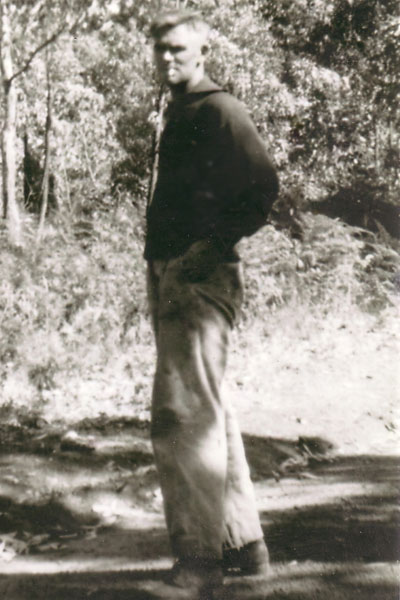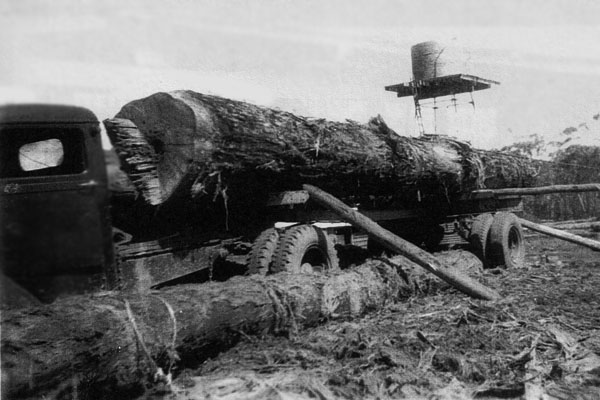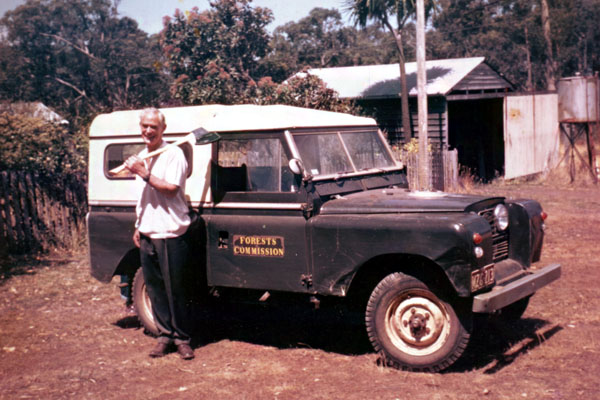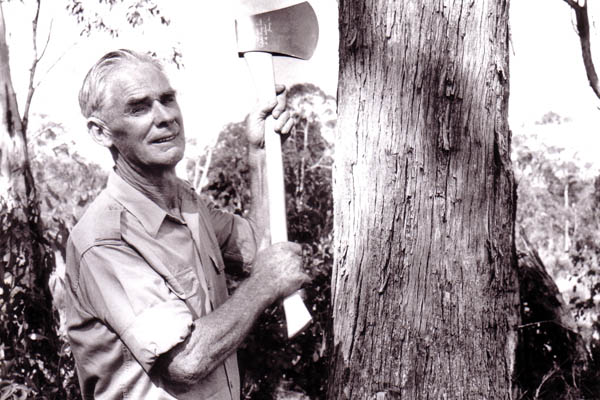Henry (Tim) Hodgetts
FCV Overseer
"On reflection, a tribute must be made to the Forest Overseers who had the grass-roots control of the forest management during the 1960s. Tim Hodgetts at Gorae, Stringy Aldridge had Narrawong, Central Cobboboonee, Dunmore and Tyrendarra, Alec Murphy looked after Greenwald and Dartmoor, Dick Aldridge had charge of Drumborg, Annya and Myamyn while Bob Riley was at Digby and Hotspur. These five officers had the welfare of the forests and treated their respective charges as they would have done if it had been their own farms. They were all quick to defend against any desultory remark or criticism of their methods by outsiders or external departmental personnel." {Source: K Morrison, DFO Heywood, 1960s.)
The remaider of this article is taken directly, with permission, from
"Of Sawyers and Sawmills. A History of the Timber Industry in Victoria's Far South West. Garry Kerr. 1995
Records held by the managers of this site indicate Tim became an Overseer in 1952.
Tim Hodgetts was born in Portland in 1908, the second youngest of a family of eight boys and four girls. The family lived in a house close to the North Portland school, which he attended till the age of 13. His father had, for many, years been a haulier with his own bullock team, but in Tim's boyhood he was a firewood merchant.
As each of the boys left school they were put to work cutting wood for their father. Because he was rather a hard taskmaster, the boys left home as soon as they were able, and sought other employment. Tim left home when he was sixteen and worked for various Gorae orchardists, principally "Waldy" Hedditch. He also did some log falling and post splitting before joining the Forest Commission in 1941. He enlisted in the AIF in 1941 and saw action in the Middle East and New Guinea. On discharge in 1945 he rejoined the Forest Commission and remained with them for the next 28 years.
I began by talking to Tim about cutting firewood when he was a lad in the early 1920's ...
"All firewood was cut with the axe - cut in, and split off. Cut in about four to six inches, depending on the splitting of the tree mostly - you go too deep it might be too hard to split off. The wood had to be clean and dry - they wouldn't buy burnt wood off us. It had to be clean and dry. Generally speaking a good axeman could cut four or five ton of two foot wood in a day. A good man, like Jack King, would cut that before dinner - he was a very good axeman Jack - the best in the district. I could cut two or three ton when I was a kid - but I didn't have a very good axe. That's the point - you've got to have a good axe. You had to look after it - you didn't want to let the point get thick - you had to file it back every couple of days to keep it to a thin edge. You had a smooth stone, which you carried in your pocket, and you give it a rub every now an' then. Once it got a bit thick you had to go to a file to take it off, then start again with the stone."
"I think it was about five shillings a ton they got for it. Two and a half ton they used to put on the dray, and I don't think they got any more than fifteen bob for a dray load. I didn't get to see any money though, Dad kept that (Laughter). We never got to town much either - we stopped behind and cut."
"We'd cut till dinner time, till he got his load, then away he'd go, and we'd cut next days load. He didn't cut much, we did all the cutting."
Tim talks about axes and saws ...
"The best axes were Kelly's and Plum. A Kelly was a good axe, but Plum was the better. Hickory made the best handle. You had to have a good handle for cuttin' firewood because you twist the handle as you split and the wood flies off. If you had a bit of ol' spotted gum or something the head would fly off with it! Wattle makes a good handle, I've used those. Tommy Johnstone used to make wattle axe handles, make 'em by hand. They were quite good handles, but not as good as hickory. Tommy reckoned they were better than hickory of course." (Laughter)
"The original saw was what was known as a peg tooth. Then they advanced to "M" tooth, which of course was like an M. Then they developed the peg and rake. It was a peg tooth with a rake to rake the centre out as they cut. The pegs would go along and cut, and the raker would come along and take the centre out. That was a fast saw for those days. It all developed in my time, then of course came the chain saws."
"My uncle Tom who had this place was a champion axeman - he used to fall logs. I've cut logs here too, for Clay and Pitts who had the mill at the Gorae siding. I cut them all with the axe on my own. You couldn't fall logs with a crosscut saw on your own, till someone invented the "Dunlop". It was a bike tube on a stick about six or eight foot high - you pulled the saw through against the bike tube and the bike tube pulled it back, so one man could saw on his own. Yes, that's what it was called, Dunlop. Steve Holmes was the first one I saw falling logs with a Dunlop. "Best mate I ever had", he said, "never answers back!" (Laughter)
"I split a lot of posts. That was a good money spinner, splitting posts - probably made more money splitting posts than falling logs. I worked with a mate ocassionaly - sooner be on my own. I'm a loner still, really. That's why the job in the forest suited me - you might go all day an' see no one, that doesn't worry me. Plenty to see in the bush I reckon."
I questioned Tim on how many posts he could split in a day with an axe, cross-cut saw, maul and wedges ...
"I have split a hundred. It wouldn't be too difficult to split a hundred if you got the right timber. I could split a hundred, yes. You get up in the Cobboboonee forest up here, splitting peppermint posts, they're very good. There's none about here, this is all messmate. With a peppermint you don't need wedges. Here you have to have maul and wedges to split, and I have split a hundred of them. But up there, two men, one hits one end with the axe, and the other hits the other end with the axe, and it's in halves! Never use the hammer and wedges - two axes. I've seen two of the Oakleys have a hundred by ten o'clock. Henry down the road here, and Mervyn - great toilers."
"1941 I went on the forest. They come looking for me, I didn't go looking for them. I was a forest worker see, so an old chap from the forestry came down looking for me to go and work for them. I called in at Hedditches on the way and said, 'I'm goin' to the Forest'. More money in the forest - a pound a week more. Four pound working for the forest and three pound working for the "cocky" - so I got a pound a week rise. When I came back from the war, I was only back two days when they come looking for me again. So I spent the rest of me working life, 28 years, working in the forest. The chief forester was in Heywood, but I was in charge of this district, eventually".
I questioned Tim on forms of transport ...
"When I first started I was only working close to home and had a pushbike. In the summer I got a job - 'fire rider', they called me, looking for bushfires. There were no towers. I'd ride round to see if I could see a smoke or anything. I might ride 30, 40 or 50 mile a day through the bush on bush tracks. If I got a puncture I had to walk home! (Laughter) But I only walked once. That didn't last long and I got a ute. They put me on a shilling a mile or something. I had to keep my own mileage and they'd pay me for it. Then, after so many years they gave me a Land Rover."
I asked Tim what selecting mill logs entailed ...
"You've got to know the tree - you "sound" the tree with an axe to see if it's solid. A solid tree gives a bright, clear, sharp, sound, a rotten tree gives a dull sound. The more rotten it is the duller the sound gets. I don't think you could teach people how to do it - it comes natural, or you learn by hard work fallin' them with an axe. You learn the hard way. But as I said, I fell a lot with the axe and I learnt the hard way. But I also had a good teacher, my uncle Tom. He was the best man at telling a solid tree that I've ever run into. You don't want to be cutting down rotten trees with an axe, you waste too much time and money."
"A tree had to be at least 18 to 20 inches through at the butt, to as big as you like, if you were good enough, which I was. The old man before me was taking this size, (approx. two feet through at the butt) and I was taking up to this size, (approx. three feet through) so I had a bonanza. I got plenty of big logs. The two mills down here, Clay an' Pitts and the other one, had to change from single saws for breaking down, to twin saws, one above the other, because of the size of the logs. Of course the revenue of the forest grew tremendously because of the bigger logs."
"The old chap who was doing the job before me was still here when I came on the job, when I was just a worker. But one day he said, "Come on, you can come with me today." He took me an' showed me a log he'd got with a thousand feet in it. He was very proud of it. That's a fair lump of a log, but I poked that up to over three thousand. I had plenty over three thousand around the same country later on. He wasn't game to mark them ... he wasn't game. The fallers didn't like falling them either. But after that we got a lot of big ones. We actually fell one - Ken Douglass and I fell it - and we measured it and there was four thousand eight hundred and sixty four super feet in it. Not too many people in this district would believe that, but it's true. You can ask Ken."

Tim Hodgetts
Abt 1940
Source: G Kerr

The 4864sup ft (72ft long) sawlog at Thomas's sawmill
1954
Source: G Kerr
I ventured to ask Tim if he thought the forest was properly managed today ...
No, certainly not. They've got the idea of clear felling. They go into a patch and fell everything at a face, down to the one size. I don't believe in that, I believe in selective felling. A tree can be that size, (two feet through) and growing like a mushroom, in healthy growth, let him keep going. They fall them today down to about 15 inches - no good. It's not good timber. They warp and twist when they're young. The bigger the tree the better the timber."
"This is a slow growing forest - 60 years at least to grow a tree. Doug Beauglehole and I once had a job of going round counting rings. See, they make a ring for every year. We couldn't find a decent mill log under 90 year old. We'd follow the faller, and as he fell them we'd have a look. Yes, 90 years, that's pretty old. The ones they're falling today wouldn't be that, they'd be 30! They're only small - saplin's! No good!"
"I'd select logs depending on what they were to be used for. You wouldn't fall a tree of sixty feet for a mill log, you'd use him for a pile or something like that. I put in months and months searching the bush for piles. We had an order for several thousand piles for Port Pirie one time - 40 footers with a nine inch head. Most posts were split from peppermint - people liked them because they were easier to split. To get a post to last they need to be split and put in the ground, they shouldn't be let dry out, which was a great habit in the old days. A young tree's no good for posts, you want an old tree, but of course you've got a job t' get people t' believe it. In my early days in the bush Jack King and Kenny Hughes used to be splitting posts. If I marked them a small tree they wouldn't have it! They'd go and split these great big old fellows that weren't any good for anything else, they'd last for years. A young sappy tree won't last."
"There's a place up the road here a mile or so we call Moore's Folly. There was a fire that burnt through there very savagely, I think we might have lit it for sheep, but it didn't destroy anything. The forest officer at the time said it was destroyed so he rung all the trees that were there, every tree, because he reckoned they were all going to die anyway. But they won't die! Anyway they rung them all and the young stuff come up thick like a crop of oats and its been like that ever since. Now that's when I was twenty one, that's sixty two years ago. Hasn't grown a mill log and it never will grow one. I wanted to go through and thin them out and then they would grow, but no, they said they'd grow. One corner which I did thin, grew some logs."
"When I was a young fella there was a lot of sleeper cutters in the bush, cutting them with a broad axe. Jack King was an exceptionally good cutter. He'd cut nearly twice as many in a day as anyone else. Later on, when I was with the forestry, they wanted some beams for the pier. I marked the trees for him and he cut them with the broad axe. He was a good fella Jack, he and I went to school together. He came to me one day and he said, "Tim, do you think you can find me a tree to cut a fifty eight foot beam out of. It doesn't have to be free of heart. Fifty eight feet long, fourteen by twelve", he said. "Well I know where they all are", I said. So we went around the next day and looked at this one and that one. Eventually we came to the Boiler Swamp, where Kings mill was. I said, "There's one down here Jack". He looked at it and he said, "I think it might, I think it might".
"Next morning he called in and he said, "I don't think it will Tim, because I can't fall it low enough". "Yes you can", I said, "Because I'll come and give you a hand." He had to cut it right down at the earth to get the length you see. Anyway we got it, and got it carted in. Perc Pedrazzi dragged it out for miles with the horses to the road to load it on a truck. That was the keel for the first barge built in Portland, when the harbour was being built. Fifty eight feet was a long tree for this district. The longest tree I ever fell was seventy four feet. It was a seventy four foot pile. When you fall a pile, you take whatever length he is, and they pay for it. If they want sixties, and you fell a sixty three, they'd pay you for sixty three."
"There was money to be made by running sheep in the bush - if you could burn it. If you can't burn it there's nothing. That's what my uncle did for a living - he run sheep. He had two thousand sheep in the bush! I'd be down at his place and he'd give me a box of matches - this would be in September or October, not the bushfire time. He never lit a bushfire in his life. I'd go with him, ride the horse, drop a match here, drop a match there. They'd burn perhaps a hundred yards and go out. They'd burn to where it had been burnt the previous year and go out. Never had a hope of starting a bushfire, because he was always at it, every year. Thats what the forestry turned him out over. They wouldn't let him have his licence anymore. They were wrong and he was right. He was the best bush manager I ever seen. Once they stopped him doing that the sheep wouldn't do much good, and if you got a bushfire you'd lose every sheep you had. If you had burnt patches the sheep were safe. There wasn't any fences, he'd have to go every day and ride around them. He was always in the bush ridin'."
"When he worked for the forest, he'd leave home at midnight nearly, and go to Dartmoor, straight through the bush. No tracks, ride the horse straight through. Professional bushman he was. I was good enough, but I could never do that. I can walk through the bush now and go straight to somewhere ten to twelve mile away without a track. But he'd do it in the dark!"

Tim Hodgetts
Probably early 1960s
Source: G Kerr

Tim Hodgetts with a Golden Axe presented on retirement
1973
Source: G Kerr
I have been told that the bush in this area had been much more open, with less scrub and fewer small trees in the early days. I asked Tim if he thought this were true ...
"Yes that's right. When I was young we used to trap rabbits - get a bob each for rabbits. We had a pea rifle and an old spaniel dog, and we used to go out in the bush and stand up on a log. The dog would run round and chase the rabbits and they'd hop around in the open and you could see them anywhere. Today you couldn't see one in the bush if it ran un der your nose! That's how much difference there is. There was a lot of rabbits in the bush, but now there's none."
"All the wattles and acacias thrive on fire. If you could keep fire out of the bush for fifty years they'd die. It takes fire for them to germinate. My uncle had sheep in the bush, there was quite good feed, but you wouldn't feed a sheep in the bush today. Of course they were burning, but they were defeating their own purpose by burning, in one way. But if you had sheep in the bush today a bushfire would wipe the lot out. Though in my lifetime there's only been one really bad bushfire, an' that was 1939. It started up on the Kentbruck heath at ten o'clock, by dinner time it had gone past Gorae. It burnt through every scrap of forest, Mount Clay included."
"A shepherd got the blame for that, Jack Doyle got the blame. He wouldn't have lit it on purpose of course. He might have lit it a day or two before, that can always happen. He wouldn't have lit it on purpose, I can guarantee that. I had a lot of time for Jack Doyle. I reckon he was alright. He was a clever man in the bush, Jack Doyle. He worked for Sam Malseed for a long time, up on O'Halloran's run at Kentbruck, and that's where the fire started."
I questioned Tim on his ability to find his way through the bush without tracks and without getting lost. I asked if he consciously took bearings on the sun or anything else ...
"No, I never looked at the sun. I've heard them say that the bark on one side of the tree's thicker, and all this business. No, I've never been lost, that's honest. I think once you start walking, and as long as your confidence is high, you're right. But if you lose confidence that's the end of you. No, I don't look at the sun. I've seen lots of other people lost and had to find them. I had an old mate, Charlie Price from Heywood, who was never lost. He was a great bushman. No doubt about him - he was good. But he got a bit mixed up one day and I told him he was wrong. He didn't like it, but he was wrong. We'd been workin' around a fire and we were goin' back to where our dinner was. I said, "You won't find it going that way Charlie". He didn't like me telling him, but he was wrong that time."
Tim explained to me the method of preparing bark for the building of a bark hut. The knowledge had been passed on to him by his uncle Tom, who had been born in a bark hut at Hodgetts Swamp at Gorae in the 1860's ...
"What you do first is get a stick about the same shape as the log is round and sharpen a point on it. There's two of you, one each end of the log and you shove the stick in under the bark and peel it off the log without splitting it. When you get it off you put it over a fire, not a red hot fire, but a fire with a lot of smoke. You shove it on the fire with the inside down and leave it for a while. After that you can flatten it out and it won't crack. Then you get a sharp spade, as sharp as a razor, and skim the rough bark off. To fasten it down to the frame of the but you bore a round hole through the rafter and drive a square peg through the bark and into the round hole."
